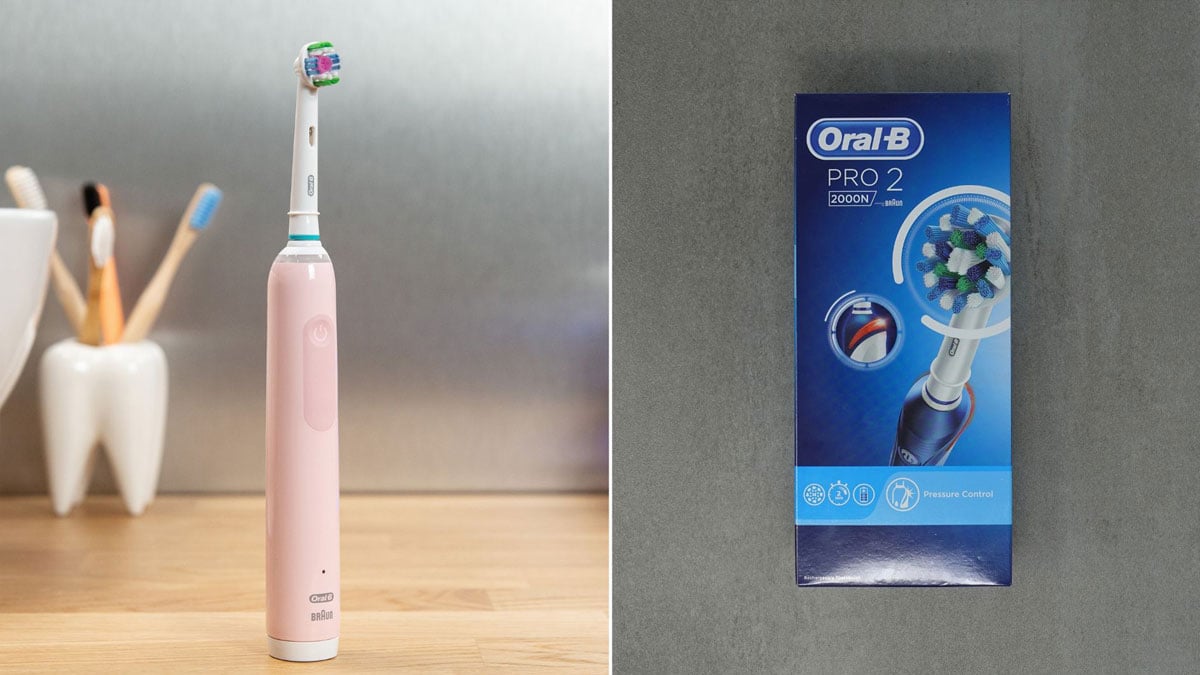
Our choice: Oral-B Pro 3 3000
The Pro 3 3000 benefits from an extra cleaning mode, a larger visible pressure sensor and a more minimal design.
Previously, we recommended the Pro 2 2000 because it was significantly cheaper, but we've noticed that it now tends to be more expensive.
Unless you can find the Pro 2 2000 for a lot less than the Pro 3 3000, we recommend the latter.

Key differences
| Find out more |
| Electric Teeth Rating |
| Retail price |
| Cleaning Action |
| Number of cleaning modes |
| Brushing intensities |
| Timer |
| Pacer |
| Pressure Sensor |
| Battery life |
| Battery type |
| Number of heads included |
| Travel case included |
| Bluetooth connectivity |
| Position tracking |
| Noise |
| Warranty |
| Electric Teeth Rating |
| Buying options |
|
Our Choice

|

|
|---|---|
| Review | Review |
|
(4.7)
|
(4.7)
|
| £90 | £70 |
| Oscillating-rotating & pulsating (3D) | Oscillating-rotating & pulsating (3D) |
| 3 | 2 |
| - | - |
|
|
|
| 30 second quadpacer | 30 second quadpacer |
|
|
|
| 14+ (plus) days | 14+ (plus) days |
| Rechargeable Lithium-Ion (Li-Ion) | Rechargeable Lithium-Ion (Li-Ion) |
| 1 | 1 |
| - | - |
| - | - |
| - | - |
| 73dB | 76dB |
| 2 years | 2 years |
|
(4.7)
|
(4.7)
|
- Handle design/colours
- The Pro 2 2000 has a larger rubber grip on the front of the handle that the Pro 3 does not have.
- The Pro 3 is available in 4 different colours (alabaster white, pink, electric blue & black onyx) compared to the 3 colours (blue, white & pink) of the Pro 2 2000.
- The grip on the rear of the handle comes in the form of lots of dimples compared to the ridges on the 2000.
- Cleaning modes
- The Pro 3 3000 has 3 cleaning modes (Daily Clean, Sensitive & Whitening) compared to the 2 modes (Daily Clean & Sensitive) of the Pro 2 2000.
- Brush heads
- The Pro 2 2000 comes with 3 different brush heads (CrossAction, 3D White or Sensi UltraThin) compared to the 4 brush heads (CrossAction, 3D White, Charcoal & Sensi UltraThin) of the Pro 3 3000.
- Pressure sensor
- The Pro 3 3000 has a larger and more visible light ring that wraps a full 360 degrees around the top of the brush handle. Whereas the Pro 2 2000’s sensor is positioned towards the back of the brush handle.
- Price
- The Pro 2 2000 has a lower retail price of £70 compared to the £90 of the Pro 3.
Please note. Every effort is made to ensure the key differences listed are correct, but these differences are subject to change without notice. Products and the box contents can be changed without notice and different variants can exist.
Detailed comparison: what’s the difference between the Oral-B Pro 2 2000 and Pro 3 3000?
The Pro 2 and Pro 3 are low mid-range electric toothbrushes from Oral-B.
Let me be clear that both are very good and I could happily use either on a daily basis.
Technically at least though, the Pro 3 3000 is the superior and arguably ‘better’ toothbrush. However, in practice, the differences are subtle and don’t make the Pro 3 an absolute must buy over the Pro 2.
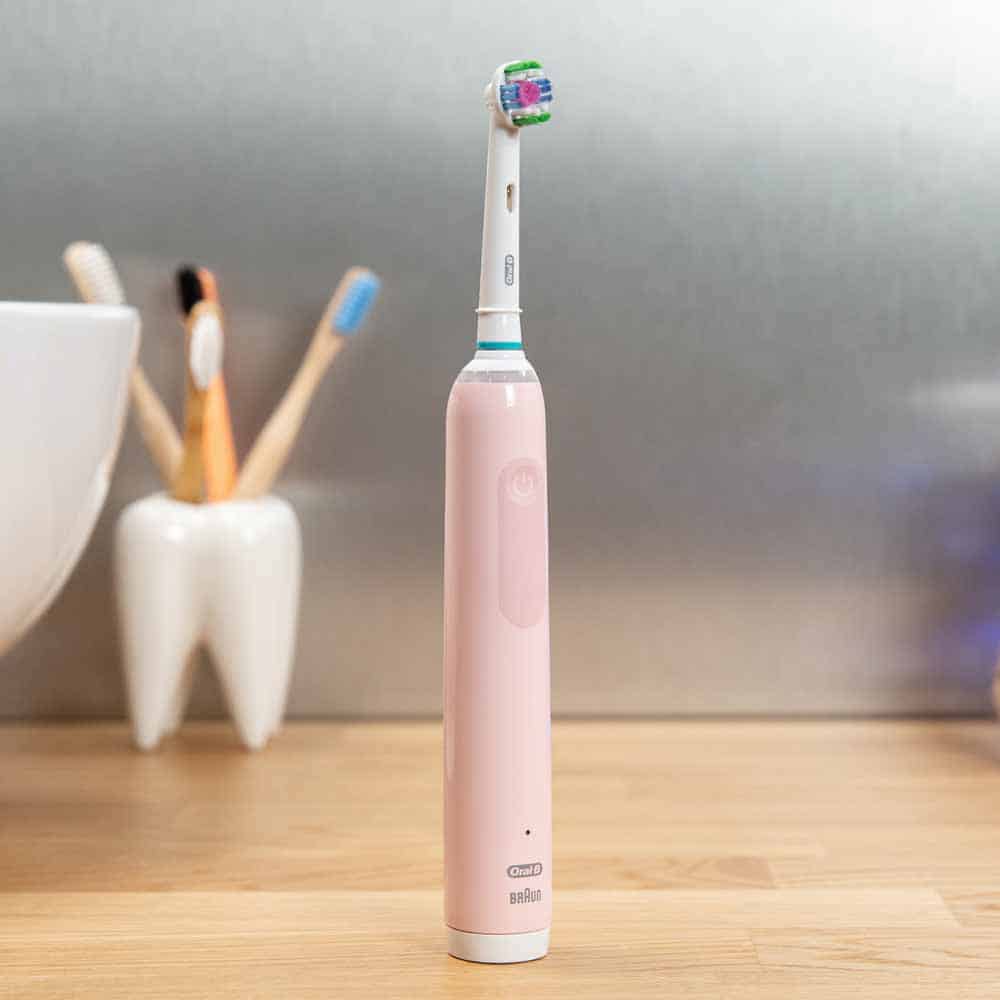
The most obvious difference, even to the untrained eye, is the design of these brushes.
With the 3000 you have a much cleaner and more minimal look compared to the 2000.
It is designed this way to mimic their top of the line iO Series and does away with the large rubber grip on the front of the handle that you find on the 2000.
The power button on the Pro 3 does provide some texture and grip for the finger. And although the 3000 is now all smooth touch plastic, it isn’t as slippy as you might expect.
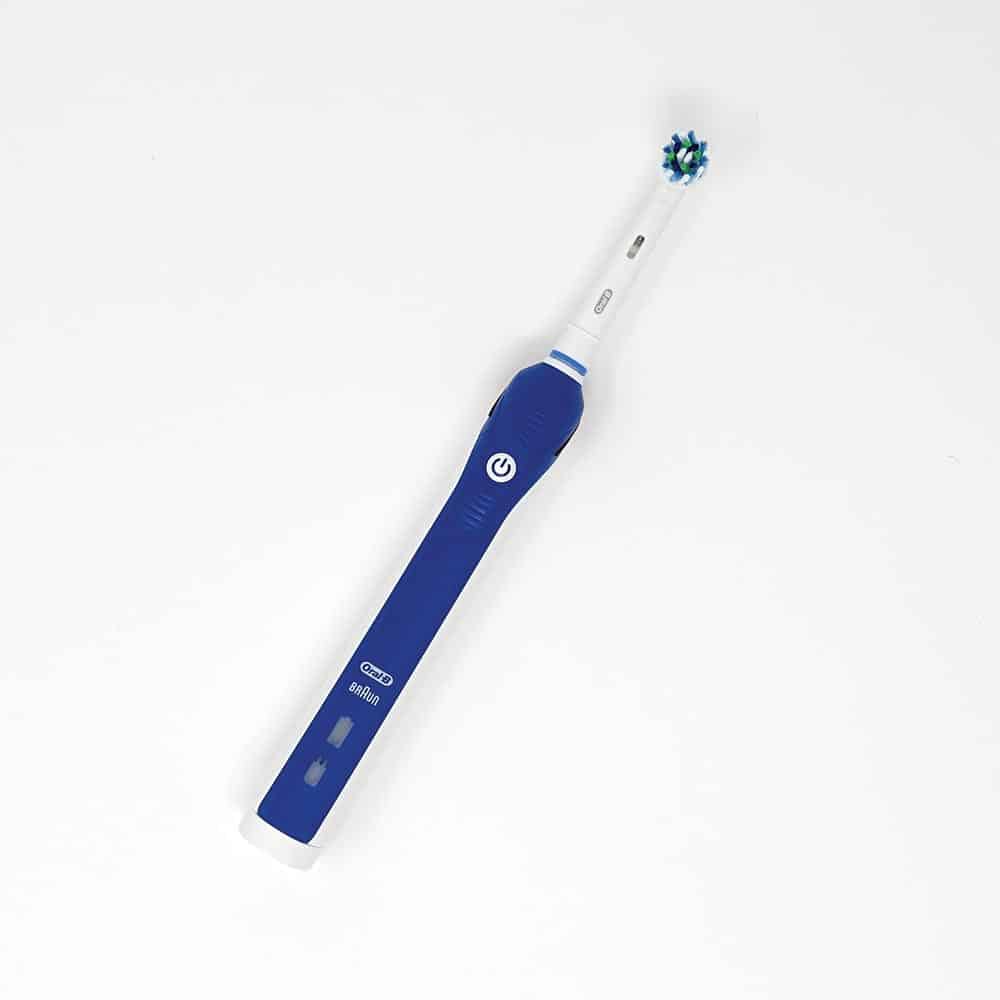
The 2000 does feel marginally more secure in hand, but the benefit is that the Pro 3 is easier to keep clean. Toothpaste residue doesn’t build up on the handle in quite the same way as the 2000 and a quick rinse or wipe rides the handle of this.
When you take a look at the back of the brush handles you come across another difference.
The Pro 2 has a series of raised ridges to provide texture and gripping points for the fingers.

With the Pro 3, there are a series of dimples running from the top to the bottom of the handle. These dimples are far more subtle in appearance. They do provide texture onto which the fingertips can grip, but they are not quite as effective as the raised ridges on the 2000.
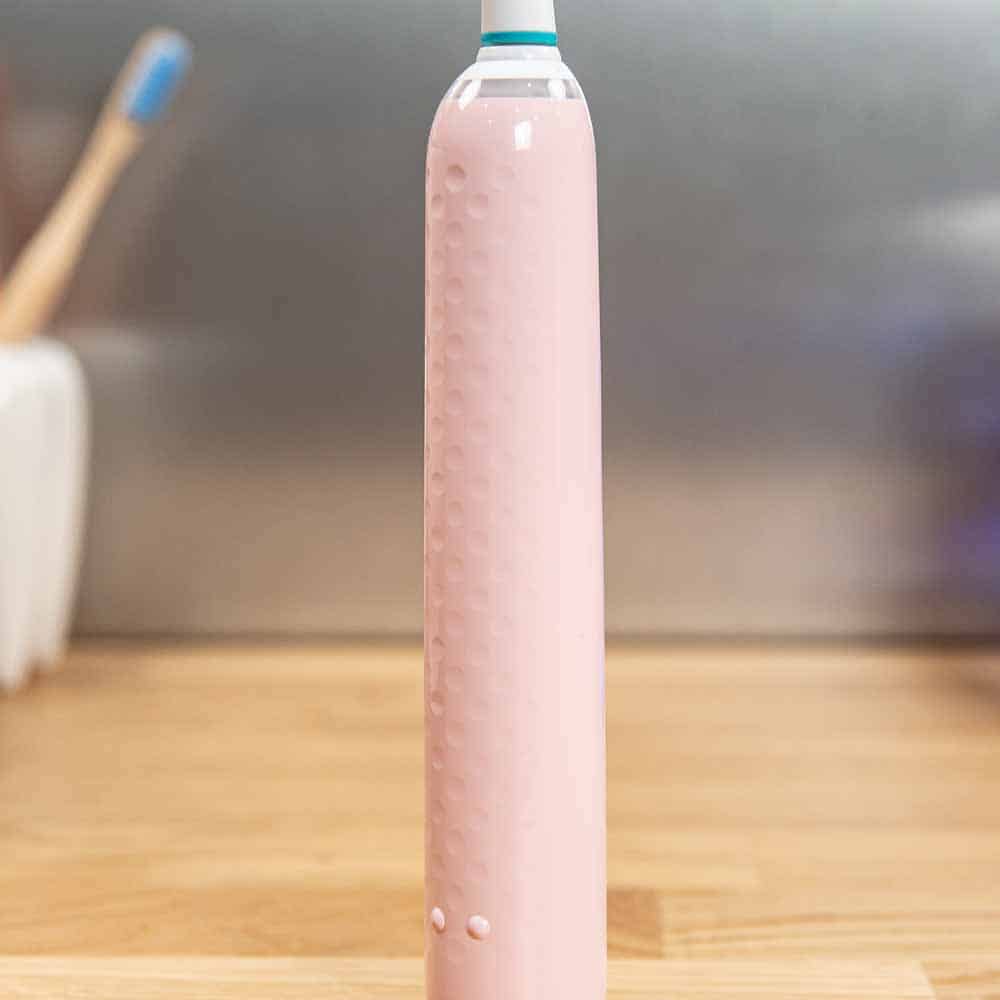
Handle colour options have changed too.
With the 2000 it is the rubber grip in blue or pink that contrasts against the white plastic body of the brush. Although there is a white gripped variant too.
With the Pro 3 there isn’t the same 2 tone effect. Instead, the plastic body of the handle is 1 solid colour be that alabaster white, pink, electric blue or black onyx.
An additional design change with the Pro 3, is the introduction of a LED light ring around the neck of the brush handle. It wraps a full 360 degrees.
This is similar to the premium Genius and iO series brushes that Oral-B offers.
The light colour is not customisable, nor does it stay lit the whole time. But, when the built-in pressure sensor is activated, the light ring is lit red.
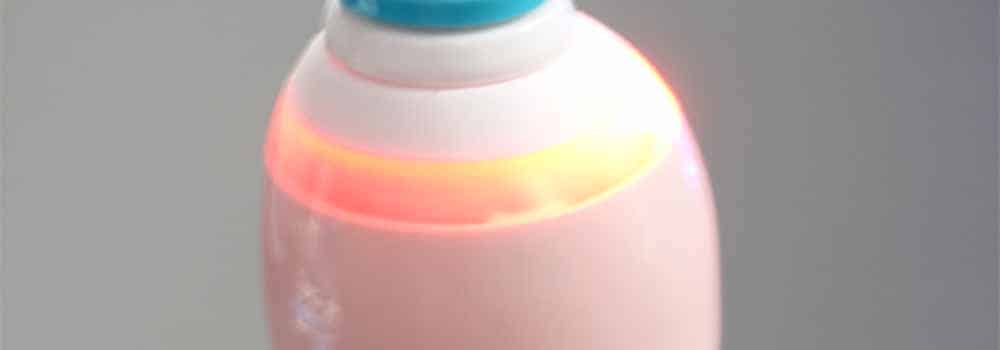
The Pro 2 2000 has a visible pressure sensor, but unlike the Pro 3, this is positioned primarily on the back of the handle. It has a red plastic panel compared to the white of the Pro 3. Both light up and are visible, but the extra surface area of the Pro 3’s sensor makes it a slightly more practical implementation.
Design aside, they do the same job. When the sensor is activated they both light up red to alert you that you are brushing too hard. Reduce the pressure and the lights go out.

The final technical difference between these 2 brushes is the cleaning modes available.
Both offer the standard daily clean mode and a more gentle sensitive mode. But, the Pro 3 offers a third brushing mode, known as whitening.
Whitening is designed to assist with polishing the tooth surface and achieving a brighter and whiter smile, by more effectively cleaning away external surface stains on the teeth.
Whilst it may provide some benefit, particularly if used with a 3D White brush head, the differences are going to be extremely subtle, if not impossible to notice.
Your brushing technique, routine and diet will have a bigger impact on your teeth and making them whiter than the brushing mode alone.
It should be noted, that the brush heads supplied with either the Pro 2 2000 or 3 - 3000 can differ. Most common is the CrossAction or 3D White brush head. But there are a few different options.
I list them below, but you should know that all the heads are available to purchase separately and are interchangeable, should you have a preference.
The Pro 2 2000 range:
- Blue gripped handle - CrossAction brush head (white plastic shaft)
- Pink gripped handle - 3D White brush head (white plastic shaft)
- White gripped handle - Sensi UltraThin brush head (white plastic shaft)
And the Pro 3 3000 range:
- White handle - CrossAction brush head (white plastic shaft)
- White handle - Sensi UltraThin brush head (white plastic shaft)
- Prink brush handle - 3D White brush head (white plastic shaft)
- Blue handle - CrossAction brush head (white plastic shaft)
- Black handle - CrossAction brush head (black plastic shaft)
- Black handle - Charcoal brush head (white plastic shaft)
Does one clean better than the other?
No.
Assuming you use either brush handle with the same style of brush head then there is no difference between the way in which these two brushes clean.
Use the Pro 2 2000 or the 3000 and you will achieve thorough cleaning results.
It can be argued that the additional whitening cleaning mode, offered on the Pro 3 can bring extra benefits. Potentially, it can do, particularly when paired with a 3D White brush head. However, in reality, any differences are going to be extremely small, if at all noticeable.
Is one better priced than the other?
Yes. The Pro 3 3000 now tends to be quite a bit cheaper, despite having better specs. In the past this was the other way around and the Pro 2 2000 was cheaper.
However, the Pro 2 2000 now seems to be less readily available, which has made it more expensive.
If you do happen to find the Pro 2 2000 is available significantly cheaper, say £20 less than the Pro 3, it is the better buy. The improvements you get from the Pro 3 3000 aren't worth paying too much for.
|
Our Choice

|
Our Choice

|
|
|---|---|---|
| Electric Teeth Rating |
(4.7)
|
(4.7)
|
| Amazon | £44.99 | £95 |
| Oral-B | View price | - |
| eBay | - | View price |
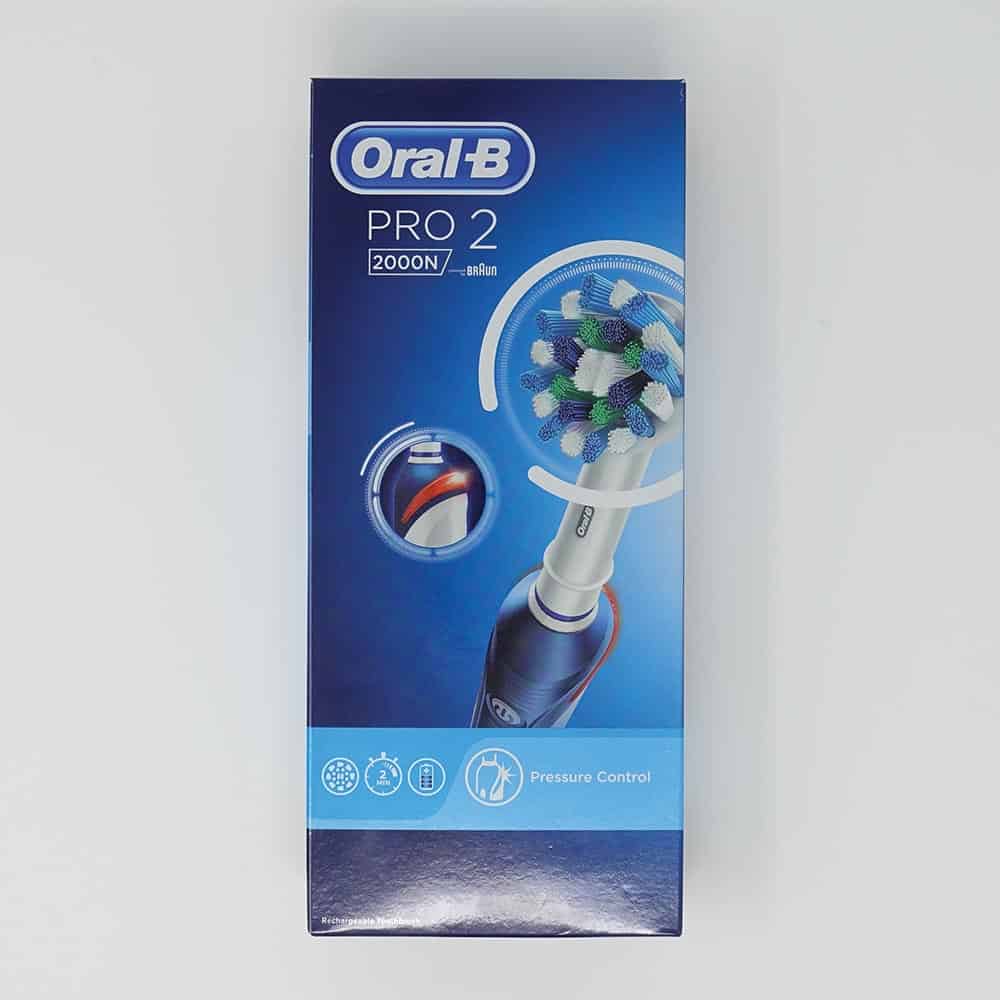



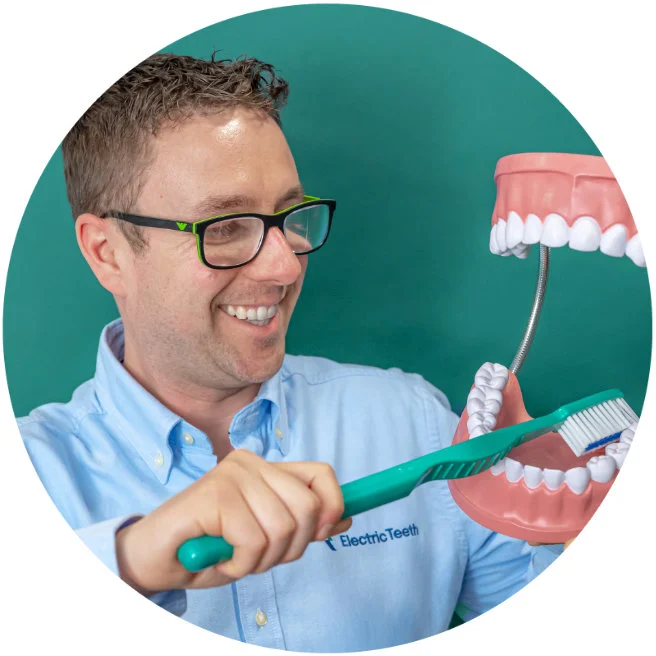

Hello there, Jon et al
Thank you very much for your website, your efforts and advice are much appreciated.
I currently have an oral b 2900 and am looking to exchange or replace having had it for circa 4 years.. However, I have found that the 2900 is increasingly unavailable,at a reasonable price, so I have just purchased the 3900 at £55 or £27.50p a stick in the black Friday sales, I note that the choices now are really between the 3900 and 4900, which again in the sales is £70 or £35 a stick, which is not bad value, but the main additional benefit of the 4900 seems to be the bluetooth connection,, which, looking at reviews is of little interest to the average user and the app itself is not highly rated.
Keep up the good work.
Best wishes
Paul Hemington
Hi Paul.
It seems like you have made the best choice. I wouldn't normally suggest people pick the Smart 4 4900 unless they really want some 'smart' features.
For most people they never use the Bluetooth or do so for a short period.
You have to be really committed and if you are there are better smart toothbrushes in our opinion.
Hi Jon
I currently have a Oral-B Pro 2 2000N that is now falling apart (had it for years though) and was wanting to replace it with the Oral-B Pro 3 3000. Can you advise if the oscillations for both.
Hi Thomas. To my knowledge, both models offer up to 9,900 oscillations and 45,000 pulsations.
Many thanks for the speedy reply and information, Jon
Interesting review.
My current brush Oral-B Triumph 5000 from 2011 (almost 11 years old) just wore down in its silicone on the front. The back doesn't matter because it is on top of hard plastic, but on the front, a hole in the silicone makes it possible for water to access the circuit boards. I believe this was the death of my brush.
What I notice in this comparison is that the design on the pro 2 2000 series is similar, while the pro 3 3000 series don't have those edges to the silicone on the front, and I think it could increase the lifespan of the brush.
10+ years on a brush seems good to me, but all the smart programs was a waste for me. However, currently, the pro 2 and pro 3 series are relatively cheap. The pro 2 cost 4 times less than my old brush, and the pro 3 is about 2 times less.
So potentially I see the pro 3 as a good choice.
But I wonder if the brush development will change with the io series. making it a short term investment to go with the pro series.
Good day
Wat is the rotation and pulsating speeds of the new pro 2 2000 and pro 3 3000 models?
Hi Andries,
The Pro 2 2000 and 3 3000 offer up to 8,800 oscillations and 40,000 pulsations.